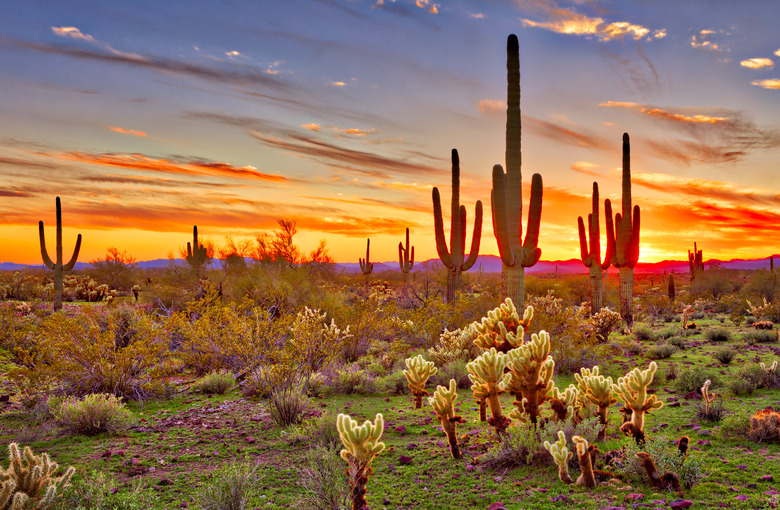Types Of Environmental Ecosystems
An ecosystem consists of all the living and non-living things in a specific natural setting. Plants, animals, insects, microorganisms, rocks, soil, water and sunlight are major components of many ecosystems. All types of ecosystems fall into one of two categories: terrestrial or aquatic. Terrestrial ecosystems are land-based, while aquatic are water-based. The major types of ecosystems are forests, grasslands, deserts, tundra, freshwater and marine. The word "biome" may also be used to describe terrestrial ecosystems which extend across a large geographic area, such as tundra. Keep in mind, however, that within any ecosystem, specific features vary widely – for instance, an oceanic ecosystem in the Caribbean Sea will contain vastly different species than an oceanic ecosystem in the Gulf of Alaska.
Forest Ecosystems
Forest Ecosystems
Forest ecosystems are classified according to their climate type as tropical, temperate or boreal. In the tropics, rainforest ecosystems contain more diverse flora and fauna than ecosystems in any other region on earth. In these warm, moisture-laden environments, trees grow tall and foliage is lush and dense, with species inhabiting the forest floor all the way up to the canopy. In temperate zones, forest ecosystems may be deciduous, coniferous or oftentimes a mixture of both, in which some trees shed their leaves each fall, while others remain evergreen year-round. In the far north, just south of the Arctic, boreal forests – also known as taiga – feature abundant coniferous trees.
Grassland Ecosystems
Grassland Ecosystems
Different types of grassland ecosystems can be found in prairies, savannas and steppes. Grassland ecosystems are typically found in tropical or temperate regions, although they can exist in colder areas as well, as is the case with the well-known Siberian steppe. Grasslands share the common climactic characteristic of semi-aridity. Trees are sparse or nonexistent, but flowers may be interspersed with the grasses. Grasslands provide an ideal environment for grazing animals.
Desert Ecosystems
Desert Ecosystems
The common defining feature among desert ecosystems is low precipitation, generally less than 25 centimeters, or 10 inches, per year. Not all deserts are hot – desert ecosystems can exist from the tropics to the arctic, but regardless of latitude, deserts are often windy. Some deserts contain sand dunes, while others feature mostly rock. Vegetation is sparse or nonexistent, and any animal species, such as insects, reptiles and birds, must be highly adapted to the dry conditions.
Tundra Ecosystems
Tundra Ecosystems
As with deserts, a harsh environment characterizes ecosystems in the tundra. In the snow-covered, windswept, treeless tundra, the soil may be frozen year-round, a condition known as permafrost. During the brief spring and summer, snows melt, producing shallow ponds which attract migrating waterfowl. Lichens and small flowers may become visible during this time of year. The term "tundra" most commonly denotes polar areas, but at lower latitudes, tundra-like communities known as alpine tundra may be found at high elevations.
Freshwater Ecosystems
Freshwater Ecosystems
Freshwater ecosystems can be found in streams, rivers, springs, ponds, lakes, bogs and freshwater swamps. They are subdivided into two classes: those in which the water is nearly stationary, such as ponds, and those in which the water flows, such as creeks. Freshwater ecosystems are home to more than just fish: algae, plankton, insects, amphibians and underwater plants also inhabit them.
Marine Ecosystems
Marine Ecosystems
Marine ecosystems differ from freshwater ecosystems in that they contain saltwater, which usually supports different types of species than does freshwater. Marine ecosystems are the most abundant types of ecosystems in the word. They encompass not only the ocean floor and surface but also tidal zones, estuaries, salt marshes and saltwater swamps, mangroves and coral reefs.
References
- U.S. Geological Survey: Merging Aquatic and Terrestrial Perspectives of Nutrient Biogeochemistry
- University of Michigan: The Concept of the Ecosystem
- Defenders of Wildlife: Types of Forests
- University of California, Museum of Paleontology: The Grassland Biome
- McGraw-Hill Higher Education: Kinds of Ecosystems and Communities
- Marietta College: The Grassland Biome(s)
- Windows to the Universe: The Desert Biome
- Windows to the Universe: Arctic Tundra
Cite This Article
MLA
Harris, Amy. "Types Of Environmental Ecosystems" sciencing.com, https://www.sciencing.com/types-environmental-ecosystems-8640/. 13 March 2018.
APA
Harris, Amy. (2018, March 13). Types Of Environmental Ecosystems. sciencing.com. Retrieved from https://www.sciencing.com/types-environmental-ecosystems-8640/
Chicago
Harris, Amy. Types Of Environmental Ecosystems last modified August 30, 2022. https://www.sciencing.com/types-environmental-ecosystems-8640/
